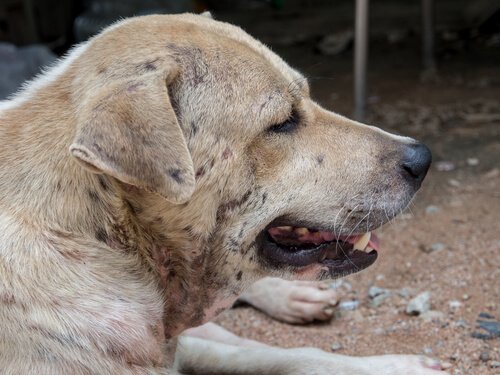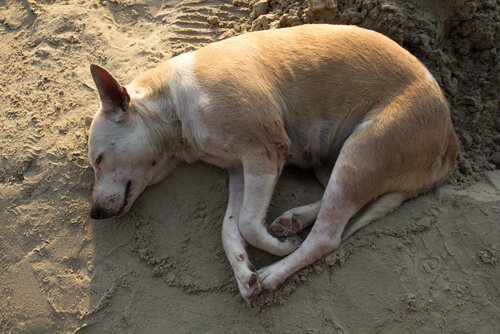Dog Dermatitis: How to Treat it

In most cases this disease is known for causing skin redness and irritation, which can lead to hair loss and infections when not treated.
Although it’s more common in stray animals, several factors can cause dog dermatitis, even in dogs that have a home. In this article, you can learn more about this skin disease and how to treat it.
What is dog dermatitis?
This is a fairly frequent disease in dog breed, but some are more prone to have it, such as the French Bulldog, Boxer, Golden Retriever, German Shepherd, and Labrador.
Dogs with long hair or those that live in warm, humid climates, have increased chances of getting dermatitis. This disease is known for causing irritated, red skin in mild cases. If it’s not treated, it causes hair loss and infection.
Different factors can cause dog dermatitis and the signs are quite visible. The animal will be constantly scratching, licking, or biting himself. The dog’s skin will turn red and thick, he will constantly stink, experience hair loss, and have dandruff, rashes, or flakiness. Likewise, he can also have sores, hot spots, eczema, and ear infections.

Types of dog dermatitis
In order to treat this disease properly, it’s very important to determine what type of dermatitis the animal has. Continue reading to learn what types exist:
1. Atopic or Allergic Dermatitis
This is one of the most common types. It appears when the animal is genetically predisposed to develop allergies. Mites, flower pollen, or insect bites can trigger this type of dermatitis.
The affected areas are on the legs, face, belly, groins, and armpits. The main symptoms are red skin, pimples, dryness, and darkening of the affected area. Veterinarians prescribe medications with antibacterial or moisturizing properties to soothe itching.
2. Fungal Dermatitis
Some breeds of dogs that have folds or wrinkles, such as the Shar Pei, Bulldog, or Neapolitan Mastiff, accumulate grease and moisture in those difficult-to-clean areas. These areas produce fungi, and later on dermatitis.
The main symptoms are hair loss, dryness, change of fur color, pus, and bad odor. The best treatment in this case is to apply an external fungi removal cream. You must complete the medicinal treatment in order to prevent the microorganisms from reappearing. Also, you can prevent it by keeping the affected area very clean.

3. Contact Dermatitis
This is another type of dog dermatitis that can affect any dog breed. It appears when the animal comes into contact with any substance that is harmful to its health, such as floor cleaners, paint, swimming pool chlorine, cleaners, etc.
The skin swells, hardens, and turns red. Scabs appear and the affected animal spends all his time scratching until he wounds himself. There isn’t any specific treatment for this type of dermatitis, except for removing the substance that caused it.
4. Seborrheic Dermatitis
This type of dog dermatitis is quite common, and can be caused by excessive bathing, because it weakens the skin’s natural grease layer. Allergies to a food or the environment can also cause it. Seborrheic dermatitis causes the skin to become greasier and give off an intense odor. You can see the skin flaking like dandruff, and turn red in areas due to intense scratching.
The treatment for this problem consists of bathing with special product that allow the dermis to recover its natural state. Also, you should pay attention to what food you give your pet, because dyes or certain ingredients can make things worse.
Dog dermatitis needs to be treated with external, oral, or injectable medications. It all depends on the type and severity of the case. Veterinarians might combine more than one remedy if they consider it necessary.
In most cases this disease is known for causing skin redness and irritation, which can lead to hair loss and infections when not treated.
Although it’s more common in stray animals, several factors can cause dog dermatitis, even in dogs that have a home. In this article, you can learn more about this skin disease and how to treat it.
What is dog dermatitis?
This is a fairly frequent disease in dog breed, but some are more prone to have it, such as the French Bulldog, Boxer, Golden Retriever, German Shepherd, and Labrador.
Dogs with long hair or those that live in warm, humid climates, have increased chances of getting dermatitis. This disease is known for causing irritated, red skin in mild cases. If it’s not treated, it causes hair loss and infection.
Different factors can cause dog dermatitis and the signs are quite visible. The animal will be constantly scratching, licking, or biting himself. The dog’s skin will turn red and thick, he will constantly stink, experience hair loss, and have dandruff, rashes, or flakiness. Likewise, he can also have sores, hot spots, eczema, and ear infections.

Types of dog dermatitis
In order to treat this disease properly, it’s very important to determine what type of dermatitis the animal has. Continue reading to learn what types exist:
1. Atopic or Allergic Dermatitis
This is one of the most common types. It appears when the animal is genetically predisposed to develop allergies. Mites, flower pollen, or insect bites can trigger this type of dermatitis.
The affected areas are on the legs, face, belly, groins, and armpits. The main symptoms are red skin, pimples, dryness, and darkening of the affected area. Veterinarians prescribe medications with antibacterial or moisturizing properties to soothe itching.
2. Fungal Dermatitis
Some breeds of dogs that have folds or wrinkles, such as the Shar Pei, Bulldog, or Neapolitan Mastiff, accumulate grease and moisture in those difficult-to-clean areas. These areas produce fungi, and later on dermatitis.
The main symptoms are hair loss, dryness, change of fur color, pus, and bad odor. The best treatment in this case is to apply an external fungi removal cream. You must complete the medicinal treatment in order to prevent the microorganisms from reappearing. Also, you can prevent it by keeping the affected area very clean.

3. Contact Dermatitis
This is another type of dog dermatitis that can affect any dog breed. It appears when the animal comes into contact with any substance that is harmful to its health, such as floor cleaners, paint, swimming pool chlorine, cleaners, etc.
The skin swells, hardens, and turns red. Scabs appear and the affected animal spends all his time scratching until he wounds himself. There isn’t any specific treatment for this type of dermatitis, except for removing the substance that caused it.
4. Seborrheic Dermatitis
This type of dog dermatitis is quite common, and can be caused by excessive bathing, because it weakens the skin’s natural grease layer. Allergies to a food or the environment can also cause it. Seborrheic dermatitis causes the skin to become greasier and give off an intense odor. You can see the skin flaking like dandruff, and turn red in areas due to intense scratching.
The treatment for this problem consists of bathing with special product that allow the dermis to recover its natural state. Also, you should pay attention to what food you give your pet, because dyes or certain ingredients can make things worse.
Dog dermatitis needs to be treated with external, oral, or injectable medications. It all depends on the type and severity of the case. Veterinarians might combine more than one remedy if they consider it necessary.
All cited sources were thoroughly reviewed by our team to ensure their quality, reliability, currency, and validity. The bibliography of this article was considered reliable and of academic or scientific accuracy.
- Manzuc, P. (2008). Diagnóstico y Manejo a largo plazo del prurito. REDVET. Revista Electrónica de Veterinaria, 9(12).
- Bhagat, R., Sheikh, A. A., Wazir, V. S., Mishra, A., & Maibam, U. (2017). Food allergy in canines: A review. Journal of Entomology and Zoology Studies, 5(6), 1522-1525.
- Callan Sanchez, M. R. (2021). Endoparásitos zoonóticos en caninos domésticos (Canis lupus familiaris). (Trabajo de grado, Universidad Científica del sur).
This text is provided for informational purposes only and does not replace consultation with a professional. If in doubt, consult your specialist.








